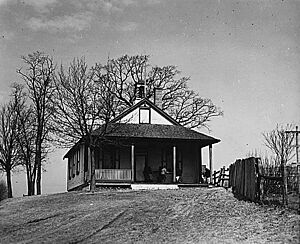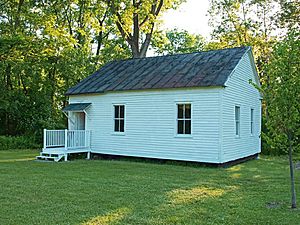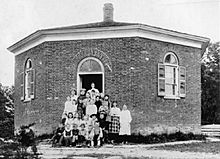One-room school facts for kids
One-room schools were once very common in many countries, like the United States, Canada, Australia, and parts of Europe. Imagine a school where all the students, from the youngest to the oldest elementary kids, learned together in just one room! A single teacher taught all the subjects to everyone.
Even though most places don't use one-room schools anymore, you can still find them in some rural or distant areas today. For example, they are still used in remote parts of the American West, the Falkland Islands, and the Shetland Islands.
In the United States, these "little red schoolhouses" are seen as important symbols of early American life and growth. Many have been saved and turned into museums. More than 200 of them are even listed on the U.S. National Register of Historic Places.
Contents
Education in Early Prussia

Prussia was one of the first countries to offer free, tax-funded education for all children, both boys and girls. This was much earlier than in countries like France or Great Britain, where compulsory schooling didn't start until the 1880s.
The Prussian system began in the late 1700s and had a big impact on education worldwide. The first schools were simple one-room buildings. However, by 1773, a model school was set up with students divided into two different age groups or classes.
Schools in Ireland
In Ireland, free primary education became law in 1831. This led to many single-teacher schools opening in the countryside. Most of these schools started in a room of an existing building. By the 1890s, almost every local area had a school.
Many of the one- and two-room school buildings you see today were built after 1891, when going to school became mandatory. Most of the schools still in use have been made bigger after combining with nearby schools. Since 2002, any state-funded school with at least 10 students gets at least two teachers. Only 21 schools, mostly on small islands, have fewer than 10 students.
In recent years, more schools have started for parents who want different options. These include Gaelscoileanna, which teach in Irish instead of English. There are also multi-denominational schools, as most Irish schools are run by Christian churches. These new schools often start with one teacher in a single room or a temporary building before they get state funding.
One-Room Schools in the United States

Many one-room schools also served as community centers. They were used as chapels on Sundays and as meeting places for local events. Since most were in rural areas, they often didn't have indoor plumbing or bathrooms.
The quality of these schools varied depending on the local economy. Most buildings were simple wooden structures, some with a school bell in a small tower. In the Midwest, some were even made of sod (grass and dirt). In the Southwest, where trees were scarce, stone and adobe (a type of mud brick) were used. While some were painted red, most were white.
The Mission Ridge School in West Virginia is a good example of an early one-room school. It was built with hand-sawed and hand-planed wood, using square nails. The blackboard was painted black, as slate boards were not common until much later. Students often used small individual slates for writing practice.
Teachers in one-room schools were often former students themselves. They were very dedicated. A student from Kentucky in the 1940s remembered: "The teachers that taught in the one room, rural schools were very special people. During the winter months they would get to the school early to get a fire started in the potbelly stove, so the building would be warm for the students." Teachers often prepared hot lunch, like soup, on the stove. They truly cared for their students' well-being.
A typical school day ran from 9 a.m. to 4 p.m., with two 15-minute recesses and an hour for lunch. Older students helped by bringing in water and wood or coal for the stove. Younger students had tasks like cleaning the blackboard or dusting erasers.
For children who lived far away, transportation was often by horse-drawn kid hack or sulky. Some students rode their own horses, which would graze in a nearby field during the day. Later, students rode bicycles. The schoolhouse was truly the heart of many small rural communities.
Most one-room schools in the United States are no longer used for teaching. They have either been taken down or changed for other uses. However, some rural communities, like the Amish, still use one-room or two-room schools for elementary education. After that, students usually go to local middle and high schools.
Octagonal Schoolhouses
Some historic one-room schoolhouses in the United States were built in an octagon shape, which means they had eight sides. This was different from the usual rectangular style. Most of these unique schools are in the northeastern part of the country. Several have been restored and are listed on the National Register of Historic Places.
Teacher's Home at School
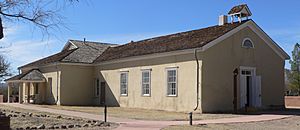
Sometimes, the teacher's home, called a teacherage, was attached to the school or very close by. If the teacher was a man, his wife and family often helped manage and support the school. Single female teachers usually lived with a local family. This was common because of the social customs of the time, which meant single women needed supervision.
Schools Combine and Change
In the 1920s, motorized school buses made it possible for children to travel longer distances to school. This meant that many one-room schools could combine into larger schools with multiple classrooms. In these bigger schools, different grade levels could have their own separate classes.
Gradually, one-room schoolhouses were replaced. By World War II, most had been replaced by larger schools, except in the most rural areas. However, they are still common in rural parts of Australia and Alaska today.
Saving History: Buildings and Culture
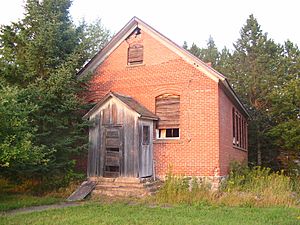
Many communities have worked hard to preserve their old one-room schoolhouses. For example, in Calvert County, Maryland, Port Republic School Number 7 closed in 1932. Over 40 years later, in 1976, a group of retired teachers decided to restore it. After months of work by volunteers, the old school bell rang again in 1977. Now, it's a tourist attraction, full of memories and old school items. A similar project was done in Queen Anne's County, Maryland. In Iowa, more than 125 small one-room schoolhouses have been turned into local museums. Some buildings have even become homes.
In Harrisburg, Nebraska, the Flowerfield School is a living museum. Fourth-graders from the area spend a day there, experiencing what a school day was like in 1888. They get to try writing with quill pens and learn about life in the past.
The One Room School House Project at Southwestern College in Winfield, Kansas, has collected information and pictures of about 880 schools across the state and nation. This project helps keep the history of these schools alive.
Active One-Room Schools Today
As of 2017, nearly 400 one-room schools were still operating in the United States. These include schools in places like:
- Death Valley, California
- Bellvue, Colorado
- Duette, Florida
- Lowman, Idaho
- Cliff Island, Isle au Haut, Maine, Matinicus Isle, Maine, and Monhegan, Maine
- Franklin, Massachusetts, Gosnold, Massachusetts, and Egremont, Massachusetts
- Copper Harbor, Michigan, Bad Axe, Michigan, Grand Ledge, Michigan, and Kalkaska, Michigan
- Northwest Angle and Warroad, Minnesota
- Goldcreek, Montana
- Goodsprings, Nevada and Nye County, Nevada
- Croydon, New Hampshire and Landaff, New Hampshire
- Sagaponack, New York and Troy, New York
- Corolla, North Carolina
- Baldwin, North Dakota
- Puʻuwai, Hawaii
- Fort Pierre, South Dakota
- Alta, Utah
- Elmore, Vermont
- Holden Village, Washington
- Marco Island, Florida
- Prudence Island
- Vilonia, Arkansas
Images for kids
-
The Knick School in Darke County, Ohio in 1996
-
St. John the Baptist Church (1841) and a one-room schoolhouse (1845) with an attached teacherage, now a working museum in Canberra, Australia
-
Port Republic School #7 in Calvert County, Maryland
-
The Eureka Schoolhouse in Springfield, Vermont, was built in 1785 and used until 1900
-
The Felta Schoolhouse in Sonoma County, California was built in 1906 and closed in 1951
-
The one-room adobe schoolhouse in Lochiel, Arizona
-
One-room school in Granite, Colorado in 1954
-
Vandalia, Indiana, Owen County, Lafayette Township District #2 Schoolhouse was completed around 1868 and closed in 1951. It is preserved by the Vandalia Community Preservation Association.
-
The Prudence Island Schoolhouse on Prudence Island in Portsmouth, Rhode Island is the last operating one-room school in Rhode Island.
-
The Brick School House in Coventry, Connecticut, was built in 1825 and closed in 1953. It is now a local museum.
See also
 In Spanish: Escuela unitaria para niños
In Spanish: Escuela unitaria para niños


